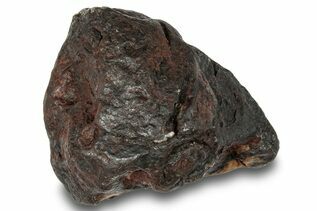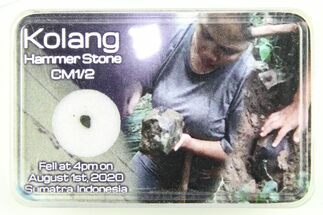Tarda Chondrite Meteorite Fragment with Case - 2020 Witnessed Fall!
These are authentic fragments of the Tarda carbonaceous chondrite meteorite, witnessed and collected near Tarda, Morocco. Each fragment weighs less than 1 gram, measures approximately .1" wide, and is accompanied by the pictured acrylic display case. The photos are representative of the specimen(s) you will receive, so there will be variation in size and shape from specimen to specimen.
Quantity discounts are available.
Quantity discounts are available.
The Tarda Carbonaceous Chondrite Meteorite
On Tuesday the 25th of August, 2020, around 2:30 pm Moroccan time, a fireball was widely witnessed by people in southern Morocco from Alnif, Zagora, Tazarine, and Rich. The fireball trajectory was from the SW to NE. A search was immediately undertaken by local residents and meteorite hunters between Goulmima and Errachidia. Hundreds of people began searching on the same day, and the first piece was found the following day by Alalou Youssef close to his village of Tarda. The fall location is crossed by the national road linking Ouarzazate to Errachidia, and because of the easy access thousands of people soon traveled to the area.
Several eyewitnesses from areas up to 150 km away were interviewed, and reported a bright yellow, barrel-sized fireball with green edges. The meteor was followed by a thick trail of white smoke that remained suspended for several seconds. The fireball was reported to release little pieces around its edges. Witnesses said the fireball was accompanied by a whistle, followed by multiple detonations. One eyewitness reported an almost vertical trajectory. Thousands of small, mostly complete stones were collected ranging from only a few milligrams to 99 grams, with a total of approximately 4 kg collected. Many pieces were recovered by hunters using magnets. The strewn field is about 3 km long and situated ~10 km east of Tarda.
Meteoritical Bulletin: Entry for Tarda
On Tuesday the 25th of August, 2020, around 2:30 pm Moroccan time, a fireball was widely witnessed by people in southern Morocco from Alnif, Zagora, Tazarine, and Rich. The fireball trajectory was from the SW to NE. A search was immediately undertaken by local residents and meteorite hunters between Goulmima and Errachidia. Hundreds of people began searching on the same day, and the first piece was found the following day by Alalou Youssef close to his village of Tarda. The fall location is crossed by the national road linking Ouarzazate to Errachidia, and because of the easy access thousands of people soon traveled to the area.
Several eyewitnesses from areas up to 150 km away were interviewed, and reported a bright yellow, barrel-sized fireball with green edges. The meteor was followed by a thick trail of white smoke that remained suspended for several seconds. The fireball was reported to release little pieces around its edges. Witnesses said the fireball was accompanied by a whistle, followed by multiple detonations. One eyewitness reported an almost vertical trajectory. Thousands of small, mostly complete stones were collected ranging from only a few milligrams to 99 grams, with a total of approximately 4 kg collected. Many pieces were recovered by hunters using magnets. The strewn field is about 3 km long and situated ~10 km east of Tarda.
Meteoritical Bulletin: Entry for Tarda
About Carbonaceous Chondrites
Carbonaceous chondrites consist of about 5 percent of known chondrites. They contain the highest concentrations of water, organic, and volatile compounds of all chondrites, and, true to their name, contain carbonate minerals! These chondrites are the least oxidized, indicating they came from the outer asteroid belt or beyond. Because of their unique compositions, they are some of the most frequently studied meteorites in the world, and have been considered as an origin for life due to their abundance of organic compounds, including amino acids.
Due to their complexity and variety, carbonaceous chondrites have several sub-classes grouped by chondrule width, each named after the type specimens of each class. CI carbonaceous chondrites, the class of finest grains, are named for the Ivuna meteorite that fell in Tanzania in 1938. CI chondrites almost entirely lack chondrules, and are composed mostly of fine-grained material that underwent aqueous alteration on their parent asteroids. Their chemical composition most closely resembles the sun’s photosphere of any chondrite. Other notable classes include:
CO and CM (Ornans/Mighei), with the smallest chondrules;
CR (Renazzo), CB (Bencubbin) and CH (high metal), which contain unique chondrules that formed from impacts after normal chondrules formed;
CV (Vigarano) and CK (Karoonda), two groups with distinctively large chondrules that formed only once at the beginning of the solar system; and
CL (Loongana), which contain large chondrule and calcium-aluminum-rich inclusions, or CAIs, but low amounts of volatile compounds and matrix.
Carbonaceous chondrites consist of about 5 percent of known chondrites. They contain the highest concentrations of water, organic, and volatile compounds of all chondrites, and, true to their name, contain carbonate minerals! These chondrites are the least oxidized, indicating they came from the outer asteroid belt or beyond. Because of their unique compositions, they are some of the most frequently studied meteorites in the world, and have been considered as an origin for life due to their abundance of organic compounds, including amino acids.
Due to their complexity and variety, carbonaceous chondrites have several sub-classes grouped by chondrule width, each named after the type specimens of each class. CI carbonaceous chondrites, the class of finest grains, are named for the Ivuna meteorite that fell in Tanzania in 1938. CI chondrites almost entirely lack chondrules, and are composed mostly of fine-grained material that underwent aqueous alteration on their parent asteroids. Their chemical composition most closely resembles the sun’s photosphere of any chondrite. Other notable classes include:
$15
Quantity Discounts
3 to 9 Pieces
$12
10+ Pieces
$10
MINERAL TYPE
Tarda Meteorite Fragment
SPECIES
Carbonaceous Chondrite (C2, Ungrouped)
AGE
Witnessed Fall (August 25, 2020)
LOCATION
~10 km East of Tarda, Morocco
SIZE
Most about 0.1" wide
WEIGHT
all <1 gram
PRODUCT ID
P-1102
 Reviews
Reviews











